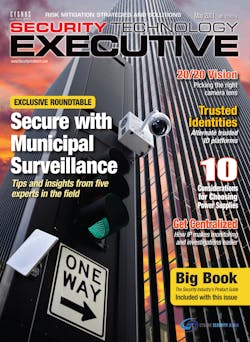Deploying a city-wide municipal surveillance system is an obviously daunting task. From technology concerns, to public outcry, to finding funding — these can be the most challenging physical security deployments, and maintaining them once they are in operation isn’t easy either.
STE recently sat down with five experts in the field of municipal surveillance so they can offer their tips, tricks and insights into what it takes to deploy and maintain such a complicated and expansive system. They represent five different municipal security deployments in the downtown areas of Dallas, Atlanta, Chicago, Wilkes-Barre, Pa., and Freeport, Texas.
Nearly all of these experts were major presenters at the Secured Cities Conference that was held in mid-May in Atlanta. Please visit www.securedcities.com to learn more.
STE: From your experience, what are the deployment/installation challenges for municipal surveillance systems?
Martin Cramer: Camera deployment and proper placement for optimum results was a challenge. In Dallas, we believe “Less is Better” regarding Camera deployment — putting a camera on every corner will not prevent crime or a terrorist attack. But strategic deployment based on crime trend analysis in conjunction with live monitoring and advanced analytics does pay off in a big way. The Public Safety Committee established criteria for determining where cameras would be deployed and how it would be funded. Camera placement was limited to City-owned property with existing power. The majority of cameras are installed on Stop Light and Street Light poles in high-crime locations with the best 360-degree view of the surrounding area. Parking lots, parks, bus stops, sidewalks and public areas are the focus of the camera system.
David Wardell: We are very fortunate in Atlanta in that the business community normally cooperates and supports City initiatives, and understands the need for partnerships. Challenges included integrating approval and implementation processes and procurement rules — in particular, in selecting vendors for services; sole-source selection justification; approval and execution of project funding; due diligence and indemnification for the municipality; and speed of action or phases.
Patrick O’Donnell: Some of our challenges in Chicago regarding deployment/ installation included:
• Finding a suitable light pole that will handle the weight of the camera equipment, while also providing an unobstructed view of the area.
• Connection/transmission issues — Some of the areas have few options for bringing the camera feed back to our network, either by direct fiber connection, wireless (wireless aggregation points may be too far away, obstructed by trees, buildings, oversaturated, etc.), or poor cellular coverage for EVDO feeds.
• Getting power to some of the locations can be quite difficult.
J.J. Murphy: Getting proper connectivity on the wireless system was a challenge. We had the system perfect for logging into the Internet, but it wasn’t powerful enough to transmit the video at the speed we wanted. So, we had to increase the amount of wireless hot points that were located throughout the city of Wilkes-Barre, and once we did that, the problem was solved.
Ty Morrow: The major challenge is to identify the existing gaps in security within a municipality. Once these gaps are identified, the entity will need to develop a strategy to fill them. At a minimum they will need to look at the following:
1. Which security company can provide the best solution for the cost?
2. Which security company has a proven track history and viability?
3. How do you identify the funding cost?
4. Establishing a budget to pay the cost.
5. Developing partners in the community to help fund the cost.
6. Developing a buy-in from your constituent base.
7. Development of an implementation strategy (you can’t get it all at once).
8. You have to sell the project, to overcome the NIMB (Not in my backyard groups).
How did you go about building support for the system — how were you able to find funding; and how did you coordinate your efforts with the business and local community?
Morrow: Selling the project was easy. The industry/business around the region were already talking about the establishment of a Port Information System (PIN), and the security project I was proposing fit nicely. I was able to sell the fact that both systems were mutually supportive of one another and had a larger Law Enforcement Nexus — other than the business being able to share information. Based on these factors, we were able to switch the focus of the project from a single-business perspective to that of a Public Safety perspective. In doing so, we were able to solidify federal grants to fund the project.
O’Donnell: Initially on the Police Department side, we were able to fund the project through a combination of money from our budget and narcotics seizures funds. Later, we were able to partner with our Office of Emergency Management and Communications for public and private grants. Our city also allowed for the Aldermen to spend money from their local ward budgets to purchase cameras for their constituents.
Murphy: We were able to get the community behind the system early on through good public relations. We outlined our problem and there was a defined safety concern, specifically in our downtown. So the cameras not only help changed the crime perception, they have also turned around the economic development in the areas that we deploy cameras. We have been very successful in all of our funding requests for both state and federal grants. The bulk of our funding came from state gaming funds in Pennsylvania.
Wardell: Support for the system was strong from the beginning from the business community. The initial funding for the project came from the Atlanta Downtown Improvement District (ADID) partnering with the Atlanta Police Foundation and the Atlanta Police who paid for the wireless signal through some existing grant funding. As the project gained notoriety for its mere existence and deterring effect, support from the public (other public agencies) and private sector at all levels continued to grow. The Atlanta Police Foundation packaged the surveillance camera program into a larger comprehensive program called Operation Shield, which included other components known as the COMNET radio system (public private venture for police-private communications), as well as the Atlanta City Worksite (ACWS), which is a Web-based information sharing platform. The Atlanta Downtown Improvement District Board of Directors represents the Business Community, and has the ability to direct where the ADID funding is spent.
Cramer: The Dallas police Department began a test project using video surveillance in 2004, viewing camera feeds from a few buildings in the entertainment district. A non-profit group, “Safer Dallas Better Dallas” (www.saferdallas.com) began a campaign to raise money for the Downtown Camera System in March 2006. The Meadows Foundation funded the first 40 downtown cameras in 2007. Another 50 downtown cameras were funded by Downtown Dallas Inc. and Downtown stakeholders in 2009. The Camera Center is staffed by “less than full duty Police Officers” and Police retirees paid for by a grant from the North Texas Council of Governments. The Police Department had to allocate funds for maintenance as the warranty expired on the downtown cameras. The City issued an RFP for downtown camera maintenance and repair. Staffing at the Camera Center continues to be a challenge. The current budget to staff the Camera Center is approaching $1 million annually. One option being explored is using volunteer camera monitors under the supervision of a sworn Police Officer.
How do you use your video investment so that it is a force multiplier?
O’Donnell: Chicago Police Cameras are well-marked and have blue lights which have a deterrent effect. Chicago command centers have software that integrates with our computer aided dispatch system, alerting monitoring officers that an incident is occurring near a camera. This allows an officer to gather intelligence and video evidence prior to a first responder’s arrival on the scene. We also use desk and light-duty officers to add extra eyes to areas that would ordinarily might not be viewed by police. They are able to conduct narcotics surveillance, look for other criminal or public safety issues in the area around the cameras. If illegal activity is observed, they are able to communicate with Police Tact and Patrol officers and identify the offender(s).
Cramer: The camera system has been effective in reducing crime and addressing public disorder and quality of life issues. The Camera Center is staffed with three operators viewing 140 cameras 24x7. That’s like deploying 140 Police Officers in a two square-mile area. Camera operators use OnSSI video analytics to assist with monitoring problem areas and late nights when activity slows down. When an operator observes something suspicious or criminal activity, a police officer is dispatched immediately to the scene to investigate.
Murphy: We created public/private partnerships with other entities that gave money for us to deploy cameras in strategic locations. We partnered with the school district, parking authority and the colleges that are downtown and the county government. They are partners in our wireless city initiative. We have more cameras located around these areas. These partnerships are a force multiplier and all of them pitch in to help with the monitoring costs.
Wardell: Being a convention and special events city, emphasis on crowd management, incident response, as well as crime prevention and interdiction are center to the City’s ability to support the desired events it attracts and hosts on a recurring (return business) basis. The camera system has served to be supplemental (more eyes) for the police, and instills confidence and the perception of safety to the local and visiting (special events and convention) population. Signage advertising the presence of a surveillance system is paramount to getting the most return on investment.
Morrow: Current technology we are using includes advanced early warning software and sensors. The video surveillance system can notify our command-and-control center if certain parameters are triggered. We can then dispatch a police officer to investigate.
How has the system increased safety and/or reduced crime in your particular deployment?
Murphy: Six years ago, there was a comprehensive study in our downtown area, and people said they felt unsafe. That has really changed now — the cameras are just one part of the project, but since the cameras have gone up, 26 new businesses have opened in the downtown area. We think the cameras have played a good role. The cameras have only been up for one year, so the crime statistics have not been analyzed, but I can tell you that we have caught everything from active drug deals to arsons in progress, officers being assaulted and an active shooter who was apprehended because of the cameras.
Cramer: Crime has dropped 45 percent in Downtown Dallas since 2007, when the cameras were installed. Other factors can impact the crime rate, but we have to give the camera system and monitoring staff a lot of credit for the drop in crime. One telling factoid is the camera system statistics vs. Police calls for service. Police responded to 13,977 downtown calls for service in 2010, and the Camera Center was involved in more than 50 percent of those calls.
O’Donnell: In 2010, 887 video surveillance-related arrests were made. A recent Urban Institute study of the Chicago cameras discovered that for every $1 of cost on surveillance, we received $4 in societal benefits — reduced crime, savings in court and corrections, less victim suffering, etc.
Wardell: It is hard to show a direct correlation between camera operations and crime reduction; however, during the first four years of camera operations, crime in the Atlanta Downtown area dropped 32 percent, and at a time of record-low police staffing. Clearly, a great deal of credit has to go to creative and aggressive policing; but, it was quite clear that the camera program being in place had a significant impact on safety and the perception of safety. In a recent survey by the Atlanta Convention and Visitors Bureau to 60 different convention shows, more than 50 percent rated Atlanta (primarily Downtown since it is convention-related) above average or better. This is in contrast to previous years’ assessments, which was largely based on perceptions.
If you could give one piece of advice to someone planning a municipal surveillance system, what would it be?
Wardell: Form a public-private planning/steering committee (partnership) from the beginning to develop a surveillance camera integrated deployment concept with program objectives. Then bring in an engineering/IT team to evaluate and develop the actual plan of action that will yield the highest return on invest sustainable through five years plus technology developments.
ODonnell: Learn from the mistakes of other cities. When we started, Chicago had separate departments working on using surveillance independent of each other and this led to duplication of effort and limited interoperability when we decided to integrate our camera systems.
Cramer: Get “buy in” in advance from all parties involved, including the Police Department, City Council, City Manager and private sector. Stakeholders need to understand ongoing expenses to monitor and maintain the camera system. Explain in detail the cost and benefits of the camera system. Will the system reduce crime and improve Public Safety? Will the cameras be monitored or will the system be used for post-event investigation?
Murphy: Talk to communities that have done it before, because the lessons learned need to be shared. There are little things you can do that can save tens of thousands of dollars.
Morrow: I have six pieces of advice:
1. Leave your ego at the door.
2. Analyze the true needs/goals of your community.
3. Develop public and private partnerships, inlcuding local businesses, churches, and civic and service organizations.
4. Talk with key stakeholders one-on-one; and get assessments on public safety concerns.
5. Develop a work committee to help develop a public safety strategy.
6. Conduct market research to see if your strategy has been implemented elsewhere; review the plan. ?


